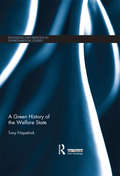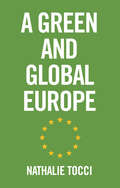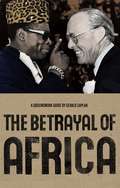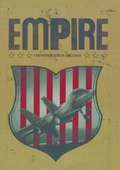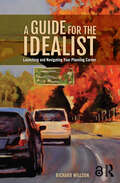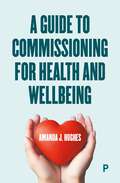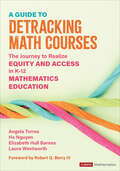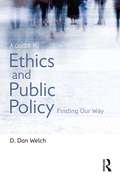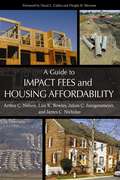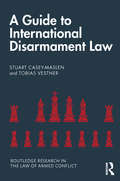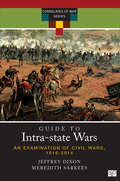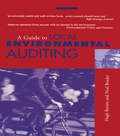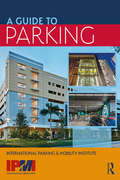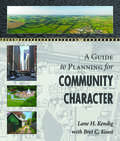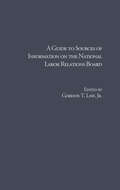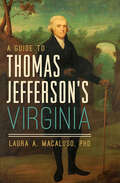- Table View
- List View
A Green History of the Welfare State (Routledge Explorations in Environmental Studies)
by Tony FitzpatrickEnvironmental problems – particularly climate change – have become increasingly important to governments and social researchers in recent decades. Debates about their implications for social policies and welfare reforms are now moving towards centre stage. What has been missing from such debates is an account of the history of the welfare state in relation to environmental issues and green ideas. A Green History of the Welfare State fills this gap. How have the environmental and social policy agendas developed? To what extent have welfare systems been informed by the principles of environmental ethics and politics? How effective has the welfare state been at addressing environmental problems? How might the history of social policies be reimagined? With its lively, chronological narrative, this book provides answers to these questions. Through overviews of key periods, politicians and reforms the book weaves together a range of subjects into a new kind of historical tapestry, including: social policy, economics, party politics, government action and legislation, and environmental issues. This book will be a valuable resource for students and scholars of environmental policy and history, social and public policy, social history, sociology and politics.
A Green and Global Europe
by Nathalie TocciAfter years of existential crisis, Europe has found a new raison d&’être: the European Green Deal and the energy transition that lies at its core. This green Europe represents a normative vision, an economic growth strategy, as well as a route to a political Union that would enhance EU integration and legitimacy. But it can only be realized if it addresses head-on the social, economic, political and geopolitical ramifications of this epochal change. In A Green and Global Europe, Nathalie Tocci explains how the unprecedented nature of the current energy transition represents both a unique opportunity and a huge challenge to Europe&’s future prosperity. The EU, she argues, must not act in isolation or ignore the adverse effects of the transition on Member States and neighbours. It must also address the global cleavages that may arise with China, the transatlantic relationship and the Global South as a result of the EU&’s green agenda. By adopting a truly global approach to the energy transition, Europe can deliver on its responsibilities to people and planet alike, and avoid unleashing social, economic and security problems that could come biting back at the Union.
A Groundwork Guide: Betrayal Of Africa
by Gerald CaplanIn the wealthy West, it's assumed that Africa is the problem and we are the solution. This timely book argues the opposite. Though couched in benevolent terms, Western policies in fact have for decades helped fuel the continent's devastating decline. Every year, far more of Africa's riches flow out to the rich world than we plough into Africa. In this systematic process of exploitation, explains author Gerald Caplan, first-world leaders work in happy harmony with African despots to wreak havoc on their nations and peoples. "The Betrayal of Africa" explains its historical background, the contemporary situation, and how a conflation of elements -- China's bold new presence in Africa, an active and angry civil society demanding government reform, and fresh leadership -- is creating the possibility for positive change. Using simple, lucid language, the book helps Western readers understand what they can do to remedy a complex, increasingly dire situation that affects us all.
A Groundwork Guide: Empire
by James LaxerThe United States presides over the most far-flung imperial system ever established. This thoughtful study compares the American Empire to those of the past, finding much can be learned from the fates of the British, Roman, Chinese, Incan, and Aztec empires. Rome, like the U. S. , was a military superpower. And just as Rome's armies were stretched thin, so too are America's -- but Rome's leaders eventually gave up on conquering Scotland. Will the U. S. do the same in Iraq? Laxer draws ominous parallels with the British, who discovered too late that empire building ultimately threatens the health of democracy at home. Documenting how the American Empire works and what it means to the rest of the world, "Empire" asks: Does the American Empire bring stability to a troubled world? Or, like its imperial predecessors, does it impose inequality and oppression on humanity? And what happens when an empire tumbles?
A Guarded Life: My story of the dark side of An Garda Síochána
by Majella MoynihanA GARDA, A FORCED ADOPTION, A FIGHT FOR JUSTICEIn 1984, Majella Moynihan was a fresh-faced young garda recruit when she gave birth to a baby boy. Charged with breaching An Garda Síochána's disciplinary rules - for having premarital sex with another guard, becoming pregnant, and having a child - she was pressured to give up her baby for adoption, or face dismissal. It forced her into a decision that would have devastating impacts on her life. Majella left the force in 1998 after many difficult years and, in 2019, following an RTÉ documentary on her case, she received an apology from the Garda Commissioner and Minister for Justice for the ordeal she endured as a young garda. Here, for the first time, she tells the full story. From an institutional childhood after the death of her mother when she was a baby, to realising her vocation of becoming a guard only to confront the reality of a police culture steeped in misogyny and prejudice, A Guarded Life is both a courageous personal account of hope and resilience in the darkest times, and a striking reflection on womanhood and autonomy in modern Ireland.
A Guarded Life: My story of the dark side of An Garda Síochána
by Majella MoynihanA GARDA, A FORCED ADOPTION, A FIGHT FOR JUSTICEIn 1984, Majella Moynihan was a fresh-faced young garda recruit when she gave birth to a baby boy. Charged with breaching An Garda Síochána's disciplinary rules - for having premarital sex with another guard, becoming pregnant, and having a child - she was pressured to give up her baby for adoption, or face dismissal. It forced her into a decision that would have devastating impacts on her life. Majella left the force in 1998 after many difficult years and, in 2019, following an RTÉ documentary on her case, she received an apology from the Garda Commissioner and Minister for Justice for the ordeal she endured as a young garda. Here, for the first time, she tells the full story. From an institutional childhood after the death of her mother when she was a baby, to realising her vocation of becoming a guard only to confront the reality of a police culture steeped in misogyny and prejudice, A Guarded Life is both a courageous personal account of hope and resilience in the darkest times, and a striking reflection on womanhood and autonomy in modern Ireland.
A Guarded Life: My story of the dark side of An Garda Síochána
by Majella MoynihanA GARDA, A FORCED ADOPTION, A FIGHT FOR JUSTICEIn 1984, Majella Moynihan was a fresh-faced young garda recruit when she gave birth to a baby boy. Charged with breaching An Garda Síochána's disciplinary rules - for having premarital sex with another guard, becoming pregnant, and having a child - she was pressured to give up her baby for adoption, or face dismissal. It forced her into a decision that would have devastating impacts on her life. Majella left the force in 1998 after many difficult years and, in 2019, following an RTÉ documentary on her case, she received an apology from the Garda Commissioner and Minister for Justice for the ordeal she endured as a young garda. Here, for the first time, she tells the full story. From an institutional childhood after the death of her mother when she was a baby, to realising her vocation of becoming a guard only to confront the reality of a police culture steeped in misogyny and prejudice, A Guarded Life is both a courageous personal account of hope and resilience in the darkest times, and a striking reflection on womanhood and autonomy in modern Ireland.
A Guerrilla Guide to Refusal
by Andrew CulpA field guide to a nonfascist life at the end of the world as we know itA Guerrilla Guide to Refusal is an unexpected approach to philosophy from a guerrilla-logic point of view. Harnessing critical theory to creatively reimagine counterinsurgency, guerrilla warfare, and interventions beyond the political mainstream, it takes us on a journey through anarchist infowar, queer outlaws, and black insurgency—through a subterranean network of communiques, military documents, contemporary art, political slogans, adversarial blogs, and captive media. In doing so, it provides powerful new insight into contemporary political movements that pose no demands, refuse labels, and offer no solutions.Written to both inspire and provoke, A Guerrilla Guide to Refusal urges us to think through the refusal to participate in politics as usual. Author Andrew Culp demonstrates how evasion can combatively deny the existing order its power. Focusing on punk cinema, anarchist pamphlets, feminist art projects, hacker manifestos, and guerrilla manuals, he foregrounds invisibility as a novel force of disruption. He draws on concepts of criminality, fugitivity, and anonymity to bring a more nuanced understanding of how power makes things—and people—visible.The book&’s unique format is that of a theoretical manual, comprising freestanding segments instead of blueprints. Poised to reach beyond the academy into activist circles, this potent theory-in-action intervention forces us to reconsider the terrain upon which our struggles against patriarchy, anti-Blackness, capitalism, and the state operate.
A Guide To Writing For Human Service Professionals
by Morley D. GlickenStraightforward and concise, the second edition of A Guide to Writing for Human Service Professionals offers students and professionals practical tools to improve their writing. In his animated and highly accessible teaching voice, Glicken presents the rules of punctuation, grammar, and APA style in jargon-free language that’s easy to understand. Chapters include detailed, real-world examples on how to write academic papers, client assessments and evaluations, business letters, research proposals and reports, papers for mass audiences, requests for funding, and much more. Glicken provides the most comprehensive writing guide available in an engaging and digestible format, including end-of-chapter exercises that allow readers to further practice their writing and critical thinking skills. A Guide to Writing for Human Service Professionals is an invaluable resource for current and future human service professionals across social work, psychology, and counseling.
A Guide for the Idealist: Launching and Navigating Your Planning Career
by Richard WillsonA Guide for the Idealist is a must for young professionals seeking to put their idealism to work. Speaking to urban and regional planners and those in related fields, the book provides tools for the reader to make good choices, practice effectively, and find meaning in planning work. Built around concepts of idealism and realism, the book takes on the gap between the expectations and the constraints of practice. How to make an impact? How to decide when to compromise and when to fight for a core value? The book advises on career "launching" issues: doubt, decision-making, assessing types of work and work settings, and career planning. Then it explains principled adaptability as professional style. Subsequent chapters address early-practice issues: being right, avoiding wrong, navigating managers, organizations and teams, working with mentors, and understanding the career journey. Underpinning these dimensions is a call for planners to reflect on what they are doing as they are doing it. The advice provided is based on the experience of a planning professor who has also practiced planning throughout his career. The book includes personal anecdotes from the author and other planners about how they launched and managed their careers, and discussion/reflection questions for the reader to consider.
A Guide for the Idealist: Launching and Navigating Your Planning Career
by Richard WillsonA Guide for the Idealist is a must for young professionals seeking to put their idealism to work. Speaking to urban and regional planners and those in related fields, the book provides tools for the reader to make good choices, practice effectively, and find meaning in planning work. Built around concepts of idealism and realism, the book takes on the gap between the expectations and the constraints of practice. How to make an impact? How to decide when to compromise and when to fight for a core value? The book advises on career "launching" issues: doubt, decision-making, assessing types of work and work settings, and career planning. Then it explains principled adaptability as professional style. Subsequent chapters address early-practice issues: being right, avoiding wrong, navigating managers, organizations and teams, working with mentors, and understanding the career journey. Underpinning these dimensions is a call for planners to reflect on what they are doing as they are doing it. The advice provided is based on the experience of a planning professor who has also practiced planning throughout his career. The book includes personal anecdotes from the author and other planners about how they launched and managed their careers, and discussion/reflection questions for the reader to consider.
A Guide to Commissioning Health and Wellbeing Services
by Amanda J. HughesAre you a health and social care commissioner navigating the ever-changing commissioning landscape? With challenges such as limited funding, changing demands and global pandemics, we need to be clear on why, what and how we commission effectively. This book offers you a warm welcome into the often-complex world of healthcare commissioning. Amanda J. Hughes shares personal insights from her commissioning career and practical guidance that will demystify the commissioning cycle and ease the journey as you strive to achieve the best outcomes for the population. This book will help you to ensure valuable resources are directed to those with most need, that care is fair and accessible and that the solutions you put into place are sustainable for the longer term.
A Guide to Detracking Math Courses: The Journey to Realize Equity and Access in K-12 Mathematics Education (Corwin Mathematics Series)
by Angela Nicole Torres Ho Hai Nguyen Elizabeth Crawford Hull Barnes Laura Wentworth StreeterCreate a pathway to equity by detracking mathematics The tracked mathematics system has been operating in US schools for decades. However, research demonstrates negative effects on subgroups of students by keeping them in a single math track, thereby denying them access to rigorous coursework needed for college and career readiness. The journey to change this involves confronting some long-standing beliefs and structures in education. When supported with the right structures, instructional shifts, coalition building, and educator training and support, the detracking of mathematics courses can be a primary pathway to equity. The ultimate goal is to increase more students’ access to and achievement in higher levels of mathematics learning–especially for students who are historically marginalized. Based on the stories and lessons learned from the San Francisco Unified School District educators who have talked the talk and walked the walk, this book provides a model for all those involved in taking on detracking efforts from policymakers and school administrators, to math coaches and teachers. By sharing stories of real-world examples, lessons learned, and prompts to provoke discussion about your own context, the book walks you through: Designing and gaining support for a policy of detracked math courses Implementing the policy through practical shifts in scheduling, curriculum, professional development, and coaching Supporting and improving the policy through continuous research, monitoring, and maintenance. This book offers the big ideas that help you in your own unique journey to advance equity in your school or district’s mathematics education and also provides practical information to help students in a detracked system thrive.
A Guide to Detracking Math Courses: The Journey to Realize Equity and Access in K-12 Mathematics Education (Corwin Mathematics Series)
by Angela Nicole Torres Ho Hai Nguyen Elizabeth Crawford Hull Barnes Laura Wentworth StreeterCreate a pathway to equity by detracking mathematics The tracked mathematics system has been operating in US schools for decades. However, research demonstrates negative effects on subgroups of students by keeping them in a single math track, thereby denying them access to rigorous coursework needed for college and career readiness. The journey to change this involves confronting some long-standing beliefs and structures in education. When supported with the right structures, instructional shifts, coalition building, and educator training and support, the detracking of mathematics courses can be a primary pathway to equity. The ultimate goal is to increase more students’ access to and achievement in higher levels of mathematics learning–especially for students who are historically marginalized. Based on the stories and lessons learned from the San Francisco Unified School District educators who have talked the talk and walked the walk, this book provides a model for all those involved in taking on detracking efforts from policymakers and school administrators, to math coaches and teachers. By sharing stories of real-world examples, lessons learned, and prompts to provoke discussion about your own context, the book walks you through: Designing and gaining support for a policy of detracked math courses Implementing the policy through practical shifts in scheduling, curriculum, professional development, and coaching Supporting and improving the policy through continuous research, monitoring, and maintenance. This book offers the big ideas that help you in your own unique journey to advance equity in your school or district’s mathematics education and also provides practical information to help students in a detracked system thrive.
A Guide to EC Environmental Law (Earthscan Library Collection: International Environmental Governance Set Ser.)
by Dorothy GilliesEC law is now a pervasive part of the legislation affecting business, government agencies, the voluntary sector and the individual citizen across the whole of the European Union. This uniquely comprehensive and accessible guide provides a simple and practical explanation of the most important aspects of EC environmental law. In straightforward terms it introduces the EC and its institutions and explains where EC environmental law and policy can be found. It discusses the main environmental laws relating to air and noise, chemicals and industrial risks, nature conservation, waste and water, and explains how these laws can be used to ensure environmental protection. The book also explains the EC's law-making procedures and discusses the stages at which lobbying can be used to influence the content of future EC environmental laws. Useful case studies and suggestions for further reading for those wishing to research a particular area are also included. This book will be an invaluable source of reference and practical guidance for lawyers, business, local government, environmental groups and all those needing to understand and use EC law in this area. Dorothy Gillies is a lawyer and lecturer in law at the University of Glasgow. She has worked in the European Parliament and in the European Commission's Directorate-General XI for Environment, Nuclear Safety and Civil Protection. Originally published in 1998
A Guide to Ethics and Public Policy: Finding Our Way
by D. Don WelchDeveloped by D. Don Welch during his 28 years of teaching ethics and public policy, the rationale behind A Guide to Ethics and Public Policy is to present a comprehensive guide for making policy judgments. Rather than present specific cases that raise moral issues or discuss the role a few concepts play in the moral analysis of policy, this book instead provides a broad framework for the moral evaluation of public policies and policy proposals. This framework is organized around guiding five principles: benefit, effectiveness, fairness, fidelity, and legitimacy. These principles identify the factors that should be taken into account and the issues that should be addressed as citizens address the question of what the United States government should be able to do. Organized by concept, with illustrations and examples frequently interspersed, the book covers both theory and specific issues. A Guide to Ethics and Public Policy outlines a comprehensive ethical framework, provides content to the meaning of the five principles that comprise that framework through the use of illustrations and examples, and offers guidance about how to navigate one’s way through the conflicts and dilemmas that inevitably result from a serious effort to analyze policies.
A Guide to Impact Fees and Housing Affordability
by Arthur C. Nelson Liza K. Bowles James C. Nicholas Craig Anthony Arnold Julian C. Juergensmeyer Dwight MerriamImpact fees are one-time charges that are applied to new residential developments by local governments that are seeking funds to pay for the construction or expansion of public facilities, such as water and sewer systems, schools, libraries, and parks and recreation facilities. In the face of taxpayer revolts against increases in property taxes, impact fees are used increasingly by local governments throughout the U.S. to finance construction or improvement of their infrastructure. Recent estimates suggest that 60 percent of all American cities with over 25,000 residents use some form of impact fees. In California, it is estimated that 90 percent of such cities impose impact fees. For more than thirty years, impact fees have been calculated based on proportionate share of the cost of the infrastructure improvements that are to be funded by the fees. However, neither laws nor courts have ensured that fees charged to new homes are themselves proportionate. For example, the impact fee may be the same for every home in a new development, even when homes vary widely in size and selling price. Data shows, however, that smaller and less costly homes have fewer people living in them and thus less impact on facilities than larger homes. This use of a flat impact fee for all residential units disproportionately affects lower-income residents.The purpose of this guidebook is to help practitioners design impact fees that are equitable. It demonstrates exactly how a fair impact fee program can be designed and implemented. In addition, it includes information on the history of impact fees, discusses alternatives to impact fees, and summarizes state legislation that can influence the design of local fee programs.This book should be the first place planning professionals, public officials, land use lawyers, developers, homebuilders, and citizen activists turn for help in crafting (or recrafting) proportionate-share impact fee programs.
A Guide to International Disarmament Law (Routledge Research in the Law of Armed Conflict)
by Stuart Casey-Maslen Tobias VestnerDisarmament is integral to the safeguarding and promotion of security, development, and human rights. Hundreds of millions of dollars are spent each year on disarmament operations, yet no comprehensive guide exists to explain clearly the international rules governing disarmament. This book seeks to fill that gap. It describes the international legal rules that govern disarmament and the operational, political, and technical considerations that govern their implementation. This book aims to support compliance, implementation, and further development of international disarmament law. Traditionally, disarmament focused on weapons of mass destruction. This remains a critically important area of work. In recent decades, the scope of disarmament has broadened to encompass also conventional weapons, including through the adoption of rules and regulations to govern arms transfers and measures to eliminate specific munitions from stockpiles and to destroy explosive remnants of war. There have also been four "generations" of programmes to address small arms and light weapons at national or sub-national level through disarmament, demobilisation, and reintegration (DDR) programmes during and following the end of armed conflict. While an internationally accepted definition of disarmament does not yet exist, it is widely agreed that disarmament encompasses or interrelates with prohibitions and restrictions on the development, production, stockpiling, testing, and transfer of weapons and on their destruction. In addition to clarifying these elements, chapters of this guide will also consider the relationship between disarmament and the law of armed conflict, and with the United Nations Security Council, human security, public health, and non-state actors.
A Guide to Intra-state Wars: An Examination of Civil, Regional, and Intercommunal Wars, 1816-2014
by Jeffrey S. Dixon Meredith Reid SarkeesSourcing data and analyses from the rigorous Correlates of War Project, A Guide to Intra-state Wars describes how civil war is defined and categorized and presents data and descriptions for nearly 300 civil wars waged from 1816 to 2014. Analyzing trends over time and regions, this work is the definitive source for understanding the phenomenon of civil war, bringing together an explanation of the theoretical premises driving the Correlates of War Project, along with revisions to categories of, and actors in, civil wars that have been made over the years, and data from the Nations, States and Entities civil war dataset. Features: Provides detailed case studies of nearly 300 civil wars from 1816 to 2014. Combines the systematic study of war with analyses of trends over time and regions. Includes discussion of the different types of actors in international relations and presents data from the Nations, States, and Entities dataset. Considers data describing non-state participants (rebels) in civil wars.
A Guide to Intra-state Wars: An Examination of Civil, Regional, and Intercommunal Wars, 1816-2014
by Jeffrey S. Dixon Meredith Reid SarkeesSourcing data and analyses from the rigorous Correlates of War Project, A Guide to Intra-state Wars describes how civil war is defined and categorized and presents data and descriptions for nearly 300 civil wars waged from 1816 to 2014. Analyzing trends over time and regions, this work is the definitive source for understanding the phenomenon of civil war, bringing together an explanation of the theoretical premises driving the Correlates of War Project, along with revisions to categories of, and actors in, civil wars that have been made over the years, and data from the Nations, States and Entities civil war dataset. Features: Provides detailed case studies of nearly 300 civil wars from 1816 to 2014. Combines the systematic study of war with analyses of trends over time and regions. Includes discussion of the different types of actors in international relations and presents data from the Nations, States, and Entities dataset. Considers data describing non-state participants (rebels) in civil wars.
A Guide to Local Environmental Auditing
by Hugh Barton Noel BruderSustainable development is still seen by authorities as an abstract concept. Local Environmental Auditing will help put it into practice. The book provides a comprehensive guide to monitoring the state of the local environment and establishing the impacts of local actions on global issues, and shows how current local authority policy and practice can be adapted to recognize environmental priorities. The authors provide both a guide to and an assessment of the subject: they link the processes with the issues, with specific information on carrying out the audit (including checklists, case studies and standards) and a detailed discussion of the issues and choices which local authorities may face. Clearly structured and accessible, this will be an essential handbook, both for local government departments and other local organizations, and students in a wide range of subjects, including environmental science and health, town planning, urban and rural studies, social science and politics.
A Guide to Parking
by International Parking InstituteIf you own a car, use public transportation, go to work or school, use health care, shop or dine out, or are part of a metropolitan community, parking affects you, probably in more ways than you’ve thought about. Because parking has such a huge effect on what happens in cities and towns and how the greater transportation system functions, decision-makers are beginning to realize that it’s critical to employ parking expertise at the beginning of the planning process. Designing and implementing an effective, professionally managed parking strategy can mean the difference between frustrating and costly traffic congestion and efficient, time-saving traffic flow. A Guide to Parking provides information on the current state of parking, providing professionals and students with an overview on major areas of parking and the transportation and mobility industry, punctuated by brief program examples.
A Guide to Planning for Community Character
by Lane H. KendigA Guide to Planning for Community Character adds a wealth of practical applications to the framework that Lane Kendig describes in his previous book, Community Character. The purpose of the earlier book is to give citizens and planners a systematic way of thinking about the attributes of their communities and a common language to use for planning and zoning in a consistent and reliable way. This follow-up volume addresses actual design in the three general classes of communities in Kendig's framework-urban, suburban, and rural. The author's practical approaches enable designers to create communities "with the character that citizens actually want." Kendig also provides a guide for incorporating community character into a comprehensive plan. In addition, this book shows how to use community character in planning and zoning as a way of making communities more sustainable. All examples in the volume are designed to meet real-world challenges. They show how to design a community so that the desired character is actually achieved in the built result. The book also provides useful tools for analyzing or measuring relevant design features. Together, the books provide a comprehensive treatment of community character, offering both a tested theory of planning based on visual and physical character and practical ways to plan and measure communities. The strength of this comprehensive approach is that it is ultimately less rigid and more adaptable than many recent "flexible" zoning codes.
A Guide to Sources of Information on the National Labor Relations Board (Research and Information Guides in Business, Industry and Economic Institutions)
by Gordon T. Law M. P. CatherwoodA concise history of the board in the U.S. from its inception in 1935, including an overview of current case law, and a bibliographic essay of selected secondary literature about the board.
A Guide to Thomas Jefferson's Virginia: History Through Architecture (Landmarks Ser.)
by Laura A. MacalusoTour Thomas Jefferson&’s Virginia, from Monticello to the Blue Ridge Mountains and beyond, with a guide that &“mixes historical background with how-tos&” (Daily Press). Few prominent Americans are as associated with a place as Thomas Jefferson is with Virginia. The heart of &“Jefferson Country&” is his house and plantation at Monticello, but Jefferson traveled the breadth of his home state, from his time at the College of William and Mary in Williamsburg to the new state capital at Richmond and his retreat and plantation at Poplar Forest, near Lynchburg. While spending time in the beauty of the Blue Ridge Mountains, Jefferson was inspired to write his only book, Notes on the State of Virginia. Jefferson&’s life story, and his many endeavors as a scholar and statesman, are illustrated in this guide to the state he held dear. &“This book mixes historical background with the how-tos of visiting the places Jefferson spent time, including the Wren Building at the College of William and Mary, which he attended, and the George Wythe house, where he studied law in Williamsburg.&” —Daily Press
